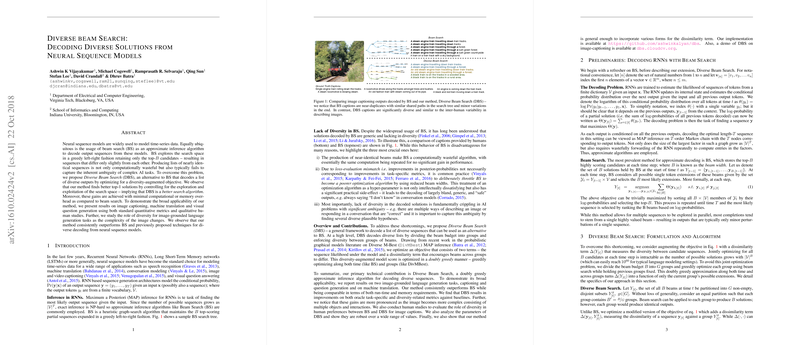Summary of Diverse Beam Search: Decoding Diverse Solutions from Neural Sequence Models
The paper "Diverse Beam Search: Decoding Diverse Solutions from Neural Sequence Models" explores the limitations of the standard beam search (BS) algorithm, particularly its inability to generate diverse outputs in neural sequence models. The authors propose Diverse Beam Search (DBS) as an alternative to BS. This method seeks to address the challenges BS faces, specifically its propensity to produce nearly identical sequences, which is inefficient and insufficient for capturing the multifaceted nature of complex AI tasks.
Key Contributions
- Introduction of DBS: The authors introduce DBS as a modified beam search algorithm that incorporates a diversity-augmented objective. This objective functions by enforcing diversity constraints among the outputs, thereby ensuring that the sequences generated significantly differ from each other.
- Doubly Greedy Approximation: DBS employs a novel doubly greedy approximation strategy. It optimizes both over time and across groups of beams, differentiating it from traditional BS that only optimizes over time. This allows for more diverse sampling from the possible output space.
- Minimal Overhead: DBS achieves its improvements in diversity with only minimal additional computational or memory overhead compared to standard BS. The method maintains the efficiency associated with beam search while enhancing its output variability.
- Broad Applicability: The paper demonstrates DBS's applicability across multiple tasks such as image captioning, machine translation, and visual question generation. It consistently outperforms BS in generating more diverse outputs on these tasks.
- Diversity Function Variants: The paper presents various forms of the diversity function, such as hamming diversity, cumulative diversity, n-gram diversity, and neural-embedding diversity, providing flexibility in application depending on task requirements.
Numerical Results
- Image Captioning: DBS showed significant improvements over BS in oracle accuracy metrics (e.g., SPICE, BLEU) and diversity statistics across datasets such as COCO and PASCAL-50S.
- Translation and VQG Tasks: For machine translation and visual question generation, DBS consistently outperformed other baseline methods, highlighting its effectiveness in generating varied sequences.
Implications and Future Directions
The introduction of DBS marks a substantial step toward improved sequence generation from neural models. By addressing the diversity shortcomings of BS, DBS enhances the ability of AI systems to model tasks with inherent ambiguities, such as generating captions or translations that reflect more varied interpretations of input data.
Future research could build on this framework to explore and fine-tune the diversity hyperparameters, further adapting the diverse beam search approach to specific applications or even broader AI domains. Additionally, integration with other methods focusing on model improvements could yield even more robust results, enhancing both the quality and variability of generated data.
The paper sets the stage for ongoing exploration into improved decoding algorithms, emphasizing the need for diversity in AI outputs, not only in theoretical models but in practical, real-world applications.
